![]()
Essentials of Physics- PHYS 101
Lecture 17-18
![]()
![]()
The source of all wave motion is:
a) wave pattern.
b) harmonic object.
c) oscillating object.
d) region of variable high and low pressure.
e) any of these.
![]()
![]()
Some questions about waves:
![]()
![]() What are the sources of waves
What are the sources of waves![]()
Typically waves arise from oscillating objects, things that are going back and forth... and back and forth. An example is a vibrating guitar string, which is the source of a sound wave.
![]()
![]() Do waves involve the transport of material? If not, what IS transported
Do waves involve the transport of material? If not, what IS transported![]()
Waves do NOT involve the net transport of material in the direction of wave travel. The air that supports a sound wave doesn't travel from the speaker to the listener, for example. What is transported? ENERGY!
![]()
![]() What do waves look like
What do waves look like![]()
In general there are two types of waves: transverse and longitudinal.
 So the movement of waves involves displacement (real or imagined) of tranport medium (caveat: in the case of electromagnetic waves, there doesn't need to be a "transport medium--" they can travel through empty space).
So the movement of waves involves displacement (real or imagined) of tranport medium (caveat: in the case of electromagnetic waves, there doesn't need to be a "transport medium--" they can travel through empty space).
Transverse waves:
- medium is displaced perpendicular to the direction the wave travels.
- Examples: guitar strings, seismic "shear" waves, water waves, light.
Longitudinal waves:
- medium is displaced (but NOT transported) in the direction of the wave.
- Examples: sound waves, seismic "P" waves.
wavelength:

period:

frequency:
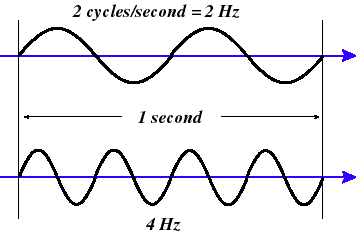
...... by the way:
speed:
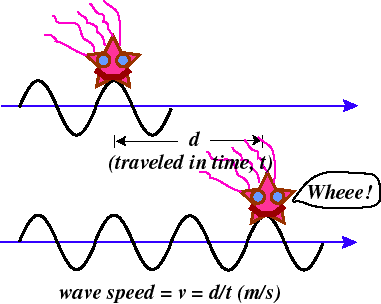
And there's a relationship between a wave's speed, wavelength and frequency.... (uh, let's see, speed is wavelength's illegitimate child by frequency's brother....)
No, its:

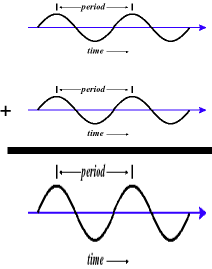
Now consider shifting the starting point of one of those waves by 1/2 wavelength. The sum of these two waves will be zero. This is called destructive interference. If these two waves are sound waves, you won't hear anything!
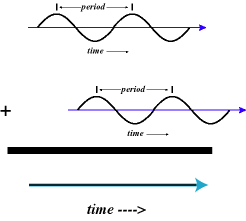
What happens to resonance frequencies when the length of the resonator changes? What happens when the speed of sound changes? Why do you sound like Donald Duck if you breathe helium?
Have you ever waited for a train to cross and notice how the sound of its "whistle" changes?
- This is called the doppler effect. It is caused because the sound source, the train in this case, is first moving towards you and then away from you.
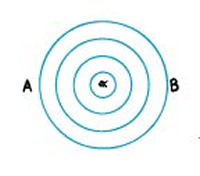
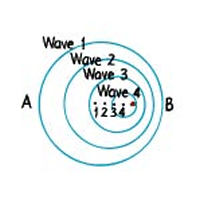
What does that "electromagnetic wave" look like again?
![]()
Light tells us about temperature
Waves refract, so does light. Waves bend when passing through glass, water, any material where it changes speed (more about that, later). White light is all colors of light combined. We can see this using a prism, as each individual color of light bends a little differently when passing through it.
The device below is set up to record the intensity of different colors of light by pivoting the prism so each color is recorded on the intensity meter. It's interesting to note that a graph of the intensity vs. "color" of light tells us about the temperature of the light source. This is how we know the temperature of the surface of the Sun when no one has been there.
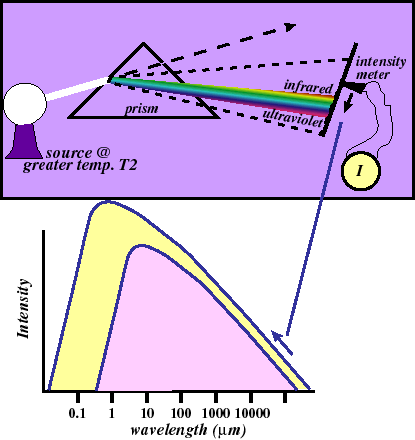
The pitch of a sound is described by its frequency. What corresponds to the "pitch" of light?
An interesting aside... the study of the strengths of different "colors" of visible and invisible light is called "spectroscopy." We can find out a lot about the atmosphere, for example, by looking at the spectrum of sunlight (where "light" also refers to invisible EM waves). Here is the sun's (average) spectrum as seen on the Earth's surface.
![]()
How do we make light (electromagnetic) waves? How can we "receive" them?
![]()
How do electromagnetic (light) waves pass through transparent materials?
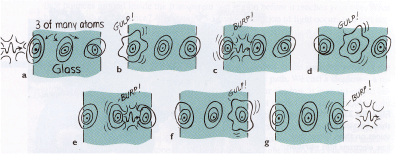
It's simple! Light is "eaten" by atoms (by shifting the orbiting electrons outward), then burped back up (the electrons move back to their original place).
The time needed to "digest" light waves is important. If its too long, the energy is absorbed by the surroundings (as heat) and the light is not re-emitted. This is called absorption. Glass absorbs certain colors of light (ultra-violet {uv} and infrared {IR}) because light "digestion" takes too long.
If digestion is short, the light is re-emitted and (possibly) absorbed by a neighboring atom. This slows down the propagation of light through tranparent materials such as glass.
![]()
Sound travels faster in:
A) air.
B) water.
C) steel.
D) a vacuum.
E) sound travels at about the same speed in all of these.
Consider a wave that travels a distance of 4 meters in 2 seconds with a frequency of 2 hertz. What is its amplitude?
A) 1 meter.
B) 2 meters.
C) 3 meters.
D) 4 meters.
E) Not enough information is given.A steel screwdriver can be magnetized using a permanent magnet when:
A) positive ions accumulate at one end and negative ions at the other end.
B) charges flow continuously from one end to the other.
C) movement of electrons around atoms line up to form domains.
D) magnetic fields caused by domains line up in the same direction.
E) proton spins in the atoms line up to form domains.A transverse wave typifies light, and a longitudinal wave typifies
A) microwaves.
B) sound.
C) infra-red waves.
D) radio waves.
E) All of these.